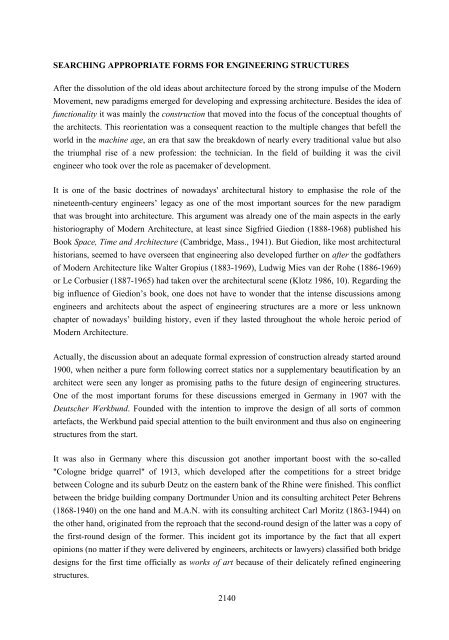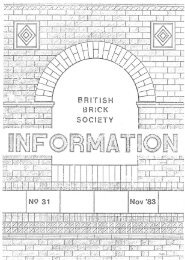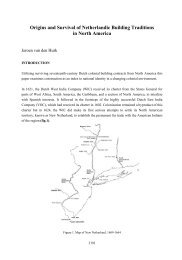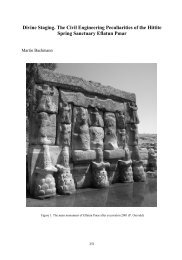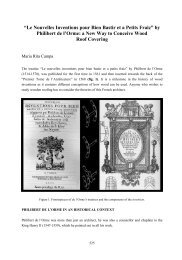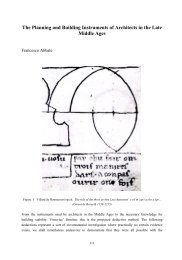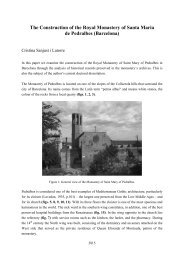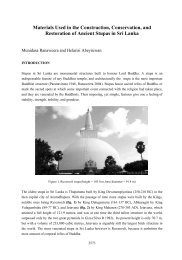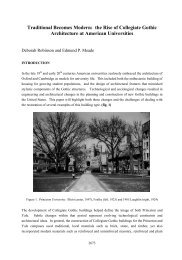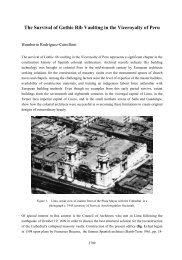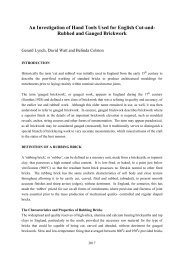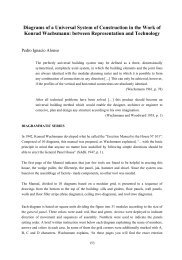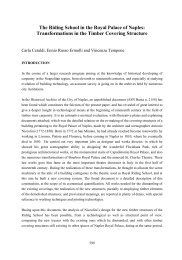Paul Bonatz and the Search for an Art - Department of Architecture
Paul Bonatz and the Search for an Art - Department of Architecture
Paul Bonatz and the Search for an Art - Department of Architecture
Create successful ePaper yourself
Turn your PDF publications into a flip-book with our unique Google optimized e-Paper software.
SEARCHING APPROPRIATE FORMS FOR ENGINEERING STRUCTURES<br />
After <strong>the</strong> dissolution <strong>of</strong> <strong>the</strong> old ideas about architecture <strong>for</strong>ced by <strong>the</strong> strong impulse <strong>of</strong> <strong>the</strong> Modern<br />
Movement, new paradigms emerged <strong>for</strong> developing <strong><strong>an</strong>d</strong> expressing architecture. Besides <strong>the</strong> idea <strong>of</strong><br />
functionality it was mainly <strong>the</strong> construction that moved into <strong>the</strong> focus <strong>of</strong> <strong>the</strong> conceptual thoughts <strong>of</strong><br />
<strong>the</strong> architects. This reorientation was a consequent reaction to <strong>the</strong> multiple ch<strong>an</strong>ges that befell <strong>the</strong><br />
world in <strong>the</strong> machine age, <strong>an</strong> era that saw <strong>the</strong> breakdown <strong>of</strong> nearly every traditional value but also<br />
<strong>the</strong> triumphal rise <strong>of</strong> a new pr<strong>of</strong>ession: <strong>the</strong> technici<strong>an</strong>. In <strong>the</strong> field <strong>of</strong> building it was <strong>the</strong> civil<br />
engineer who took over <strong>the</strong> role as pacemaker <strong>of</strong> development.<br />
It is one <strong>of</strong> <strong>the</strong> basic doctrines <strong>of</strong> nowadays' architectural history to emphasise <strong>the</strong> role <strong>of</strong> <strong>the</strong><br />
nineteenth-century engineers’ legacy as one <strong>of</strong> <strong>the</strong> most import<strong>an</strong>t sources <strong>for</strong> <strong>the</strong> new paradigm<br />
that was brought into architecture. This argument was already one <strong>of</strong> <strong>the</strong> main aspects in <strong>the</strong> early<br />
historiography <strong>of</strong> Modern <strong>Architecture</strong>, at least since Sigfried Giedion (1888-1968) published his<br />
Book Space, Time <strong><strong>an</strong>d</strong> <strong>Architecture</strong> (Cambridge, Mass., 1941). But Giedion, like most architectural<br />
histori<strong>an</strong>s, seemed to have overseen that engineering also developed fur<strong>the</strong>r on after <strong>the</strong> godfa<strong>the</strong>rs<br />
<strong>of</strong> Modern <strong>Architecture</strong> like Walter Gropius (1883-1969), Ludwig Mies v<strong>an</strong> der Rohe (1886-1969)<br />
or Le Corbusier (1887-1965) had taken over <strong>the</strong> architectural scene (Klotz 1986, 10). Regarding <strong>the</strong><br />
big influence <strong>of</strong> Giedion’s book, one does not have to wonder that <strong>the</strong> intense discussions among<br />
engineers <strong><strong>an</strong>d</strong> architects about <strong>the</strong> aspect <strong>of</strong> engineering structures are a more or less unknown<br />
chapter <strong>of</strong> nowadays’ building history, even if <strong>the</strong>y lasted throughout <strong>the</strong> whole heroic period <strong>of</strong><br />
Modern <strong>Architecture</strong>.<br />
Actually, <strong>the</strong> discussion about <strong>an</strong> adequate <strong>for</strong>mal expression <strong>of</strong> construction already started around<br />
1900, when nei<strong>the</strong>r a pure <strong>for</strong>m following correct statics nor a supplementary beautification by <strong>an</strong><br />
architect were seen <strong>an</strong>y longer as promising paths to <strong>the</strong> future design <strong>of</strong> engineering structures.<br />
One <strong>of</strong> <strong>the</strong> most import<strong>an</strong>t <strong>for</strong>ums <strong>for</strong> <strong>the</strong>se discussions emerged in Germ<strong>an</strong>y in 1907 with <strong>the</strong><br />
Deutscher Werkbund. Founded with <strong>the</strong> intention to improve <strong>the</strong> design <strong>of</strong> all sorts <strong>of</strong> common<br />
artefacts, <strong>the</strong> Werkbund paid special attention to <strong>the</strong> built environment <strong><strong>an</strong>d</strong> thus also on engineering<br />
structures from <strong>the</strong> start.<br />
It was also in Germ<strong>an</strong>y where this discussion got <strong>an</strong>o<strong>the</strong>r import<strong>an</strong>t boost with <strong>the</strong> so-called<br />
"Cologne bridge quarrel" <strong>of</strong> 1913, which developed after <strong>the</strong> competitions <strong>for</strong> a street bridge<br />
between Cologne <strong><strong>an</strong>d</strong> its suburb Deutz on <strong>the</strong> eastern b<strong>an</strong>k <strong>of</strong> <strong>the</strong> Rhine were finished. This conflict<br />
between <strong>the</strong> bridge building comp<strong>an</strong>y Dortmunder Union <strong><strong>an</strong>d</strong> its consulting architect Peter Behrens<br />
(1868-1940) on <strong>the</strong> one h<strong><strong>an</strong>d</strong> <strong><strong>an</strong>d</strong> M.A.N. with its consulting architect Carl Moritz (1863-1944) on<br />
<strong>the</strong> o<strong>the</strong>r h<strong><strong>an</strong>d</strong>, originated from <strong>the</strong> reproach that <strong>the</strong> second-round design <strong>of</strong> <strong>the</strong> latter was a copy <strong>of</strong><br />
<strong>the</strong> first-round design <strong>of</strong> <strong>the</strong> <strong>for</strong>mer. This incident got its import<strong>an</strong>ce by <strong>the</strong> fact that all expert<br />
opinions (no matter if <strong>the</strong>y were delivered by engineers, architects or lawyers) classified both bridge<br />
designs <strong>for</strong> <strong>the</strong> first time <strong>of</strong>ficially as works <strong>of</strong> art because <strong>of</strong> <strong>the</strong>ir delicately refined engineering<br />
structures.<br />
2140


